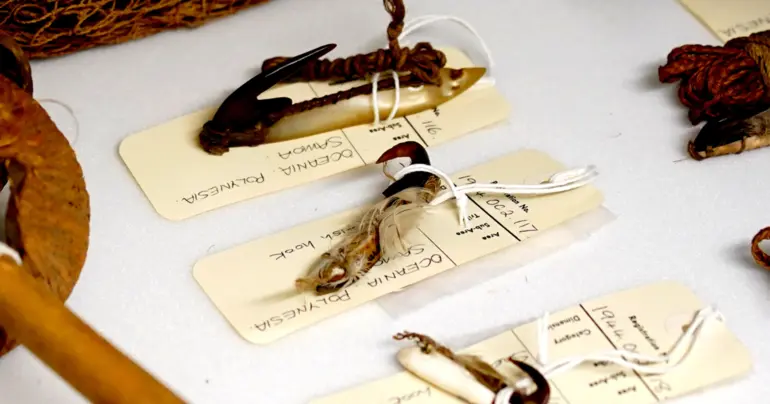MV Joyita - the mystery of Samoa's ghost ship
The MV Joyita - the merchant vessel that set sail on a routine 500 kilometre journey from Samoa to Tokelau in October 1955, but was found five weeks later drifting aimlessly near Fiji with no one on board.
On board were nine passengers and 16 crew - two were Samoan, two from Kiribati and nine Tokelauan. This incident still haunts their families and descendants. The youngest passenger was only three years old.
But what's equally inexplicable is why, decades later, only six of the 25 who were onboard have been officially declared dead. All the Europeans have been afforded that formal status through the persistence of their families.
The Joyita has been dubbed as one of the greatest mysteries of the sea. Some even regard the vessel as a ghost ship.
The 70-foot (21 metres) Joyita departed Apia for Tokelau on 3 October 1955, to take goods for White Sunday, a medical officer who was going to perform an amputation, two pharmacists with urgent medical supplies, and other passengers and supplies. Apart from the one passenger who had a considerable amount of cash to buy copra, there was nothing unusual on board.
The Joyita was supposed to have sailed at noon the day before, but was delayed because of a failed port engine clutch. Overnight, the crew tried in vain to fix the problem, but Captain Thomas Miller needed these government-chartered runs to clear his debts. He chose to leave port anyway with only one functioning engine, and also in the knowledge that the radio and pump were faulty. The journey was expected to take up to 48 hours.
But by noon on Wednesday, 5 October, the Joyita had not arrived. The weather was calm, and no passing ships or land-based stations in the region had reported a distress call. On Thursday, 6 October, officials in Fakaofo (one of three atolls of Tokelau) sent out a message: "The Joyita is overdue."
A search and rescue effort was launched immediately. From 6 to 12 October, the Sunderland flying boats from the Royal New Zealand Air Force searched more than 100,000 square miles of ocean.
Then on 10 November, just after dawn, Captain Gerald Douglas of the merchant ship Tuvalu spotted something in the distance, in the waters north of Fiji. It was a ship. As the Tuvalu approached, it became clear that something was very wrong. The boat listed heavily to port, the railing bobbing in and out of the sea. There was no sign of anyone on deck. The name on the hull came into focus - Joyita.
Everyone onboard was gone. The vessel had been equipped with a dinghy and three Carley lifeboats. All were missing. If 25 people had been left in the four available boats, each would have been near-capacity.
A formal inquiry into the fate of the Joyita was held in Apia in February 1956. It found that the vessel was in a poor state of repair, but determined that the fate of the passengers and crew was "inexplicable on the evidence submitted at the inquiry."
The story of the 'ghost ship' made international headlines at the time and sparked a variety of both bizarre and plausible theories about what might have happened to the people onboard. Even decades later, it was the subject of several books and documentaries.
Despite the tireless efforts by Tokelau leader Luther Toloa, none of the Pacific people on board have yet had that final closure because of bureaucratic apathy and incomprehensible arguments about whose jurisdiction they were under. Tokelau and Western Samoa (at the time) were both under New Zealand administration. Samoa didn't become independent until 1962 - it's New Zealand's responsibility to give the families and descendants the respect and closure they deserve.
Preliminary Conclusions
Upon spotting the Joyita north of Fiji drifting aimlessly with no one on board, before the crew of the Tuvalu had even boarded the vessel, they could already draw some preliminary conclusions.
The Joyita had been without power and at the mercy of the elements for some time because someone had rigged a makeshift canvas awning as a sunshade over the deckhouse.
It was obvious the ship had been battered by waves because the flying bridge was smashed and deckhouse windows were broken. The port-side engine clutch was still disassembled, so investigators knew the Joyita had still been running on one engine when whatever happened … happened. The other engine was covered with a mattress for reasons that weren’t immediately clear.
On deck, a doctor’s bag was found with surgical implements, a stethoscope, and some bloody bandages.
Inside, the radio was found tuned to 2182 kHz — the international marine radiotelephone distress channel. They had been trying to radio for help. Why hadn’t anyone reported a distress call?
The Joyita’s clocks, powered by the electrical generator, stopped at 10:25 and the light switches for navigation and cabin lighting were in the “on” position which seemed to indicate the Joyita lost power at night.
Almost as curious as what they did find was what they didn’t.
The ship’s log book, sextant and other vital navigational aids, plus the firearms Captain Miller kept in the boat, were missing.
Even the absence of the passengers could be seen with suspicion considering one of them was buying copra for his employer and was carrying a considerable amount of cash.
Maritime Inquiry
As the search continued, a formal maritime inquiry was organised to determine exactly what had gone wrong on the Joyita.
The official conclusions included that the Joyita’s hull was sound, but the ship had not been well-maintained — to put it bluntly, it was in extremely bad condition. The fractured cooling pipe allowed water to flood the bilges, and as the boat sank lower in the water, the one working engine would have labored and would not have been able to provide enough power to steer. With the hull full of water, it only took one large swell to rock the Joyita on its side and leave it with a heavy list.
Investigators were unable to say, however, what happened to the passengers and crew based on the evidence they found.
Main Question
And … that is the main question, isn’t it? The confounding circumstances of leaving the boat. It doesn’t make sense.
Multiple theories
Numerous theories for the disappearance of Joyita's crew and passengers have been advanced. Many were circulated at the time of the event, and several others have been put forward since. Given the fact that the hull of Joyita was sound and her design made her almost unsinkable, a main concern of investigators was determining why the passengers and crew did not stay on board if the events were simply triggered by the flooding in the engine room.
Injured Captain Theory
Captain Miller should have been well aware of the vessel's ability to stay afloat, leading some to speculate that he had died or become incapacitated for some reason (someone on board was injured—hence the bloodstained bandages). Without him to reassure the other people on board, they may have panicked when Joyita began to flood and taken to the lifeboats. However, this in itself would not account for the missing cargo and equipment, unless the vessel had been found abandoned and had its cargo removed. A friend of Miller, Captain S. B. Brown, was convinced that Miller would never have left Joyita alive, given his knowledge of her construction. He was aware of the tension between Miller and his American first mate, Chuck Simpson, and felt that their mutual dislike came to blows, and both men fell overboard or were severely injured in a struggle. This left the vessel without an experienced seaman and would explain why those remaining on board would panic when the ship began to flood.
Japanese Involvement Theory
The Fiji Times and Herald quoted at the time from an "impeccable source" to the effect that Joyita had passed through a fleet of Japanese fishing boats during its trip and "had observed something the Japanese did not want them to see." The Daily Telegraph in London hypothesised that some still-active Japanese forces from World War II were to blame for the disappearances, operating from an isolated island base. There was still strong anti-Japanese sentiment in parts of the Pacific, and in Fiji there was specific resentment of Japan being allowed to operate fishing fleets in local waters. Such theories suddenly gained credence when men clearing Joyita found knives stamped 'Made in Japan'. However, tests on the knives proved negative, and it turned out the knives were old and broken, quite possibly left on board from when Joyita was used for fishing in the late 1940s.
Soviet Submarine Theory
lso there was a proposition that "the vessel's occupants were kidnapped by a Soviet submarine, with the world at the time in the growing Cold War.
Pirates Theory
Early reports that the Joyita had been involved in a collision led to speculation that she had been rammed, and that modern sea pirates attacked the vessel, killed the 25 passengers and crew (and cast their bodies into the ocean), and stole the missing four tons of cargo.
Insurance Fraud Theory
It was also revealed that Miller had amassed large debts after a series of unsuccessful fishing trips on the Joyita. However, it would have been difficult to see the events surrounding Joyita as insurance fraud, given that no seacocks were found open and the ship would be almost impossible to scuttle. Also, Miller was relying on Joyita being chartered for regular runs between Samoa and Tokelau—these government charters would have quickly cleared his debts.
Mutiny Theory
The subsequent owner of Joyita, British author Robin Maugham (nephew of the novelist and short-story writer Somerset Maugham), spent many years investigating the vessel's past, and published his findings as The Joyita Mystery in 1962. Maugham agreed that events were started by the flooding from the broken cooling pipe and the failure of the pumps. The mattresses found covering the starboard engine were used either in an attempt to stem the leak or to protect the electrical switchboard from spray kicked up by the engine's flywheel as the water level rose. At the same time, Joyita encountered increasingly heavy swells and squally weather. Captain Miller, knowing Joyita to be unsinkable and desperate to reach his destination to clear his debt, pressed on. However, Simpson and possibly other crew members demanded that he turn back. This effectively led to mutiny, and Miller and the crew struggled, during which Miller sustained a serious injury. By now, the ship was entering heavier weather, with winds around 40 miles per hour (64 km/h), and with one engine and a flooded bilge, was beginning to labour. The flooding in the engine room would have eventually caused the starboard engine to fail, also cutting all the vessel's electrical power. Simpson was now in control and decided to abandon ship, taking the navigational equipment, logbook and supplies, as well as the injured Miller, with them. It still seems unlikely that Simpson would choose to abandon a flooded but floating ship to take to small open rafts in the Pacific Ocean. Maugham proposed that they sight a nearby island or reef and tried to reach it, but in the strong winds and seas, the rafts were carried out to sea, leaving Joyita drifting and empty. The damage to the lightly built superstructure was caused by wave damage while the vessel was drifting in heavy seas.
You can’t help but feel If we could just answer this question, all the other pieces would fall into place.
In the nautical world, it’s likewise common sense that you don’t abandon a floating ship unless it’s necessary. Experienced sailors know this. It’s yachting 101.
Furthermore, in the specific case of the Joyita, the captain knew it was virtually unsinkable due to the cork lining in the hull combined with the empty drums in the cargo hold.
Captain E.L James, harbor master at Suva, told the Kansas City Times: “She was a very buoyant vessel, very heavily planked and insulated with 5-inch slabs of cork for fish refrigeration in all three holds. She also had many empty drums in the hold. The vessel would never sink unless she broke up… I just can’t understand why everybody would have abandoned her.”
So why leave the boat? The question gives rise to many theories.
This article has been sourced from Matauala Cultural Centre and Hub, Pacific Media Network, Wikipedia and The Fiji Times.











